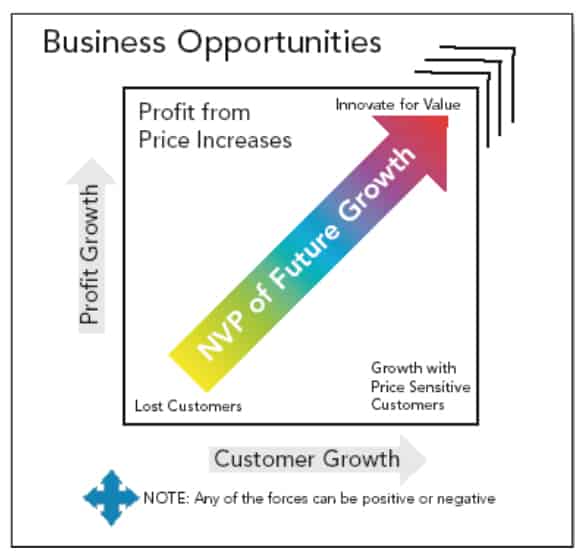Pricing for Long-Term Profit and Growth (Part 2)
In our last issue, we established the framework for performing price optimization to maximize longterm profit, by looking at the Customer Lifetime Value and the impact of pricing on the possible future outcomes. We also discussed how the “Price/Volume/Profit Tool,” a vital element for achieving Level 3 of the World-Class Pricing framework, links to this model.
In this edition, we delve into the available margin pool and extract a number of factors that could affect future profitability from a pricing management standpoint. We believe the effectiveness of a pricing strategy has to be measured over the long term, and not solely by its ability to deliver quarterly, or even annual, profit and growth targets.
In our last issue, we established the framework for performing price optimization to maximize longterm profit, by looking at the Customer Lifetime Value and the impact of pricing on the possible future outcomes. We also discussed how the “Price/Volume/Profit Tool,” a vital element for achieving Level 3 of the World-Class Pricing framework (www.pricingsolutions.com), links to this model. In this edition, we delve into the available margin pool and extract a number of factors that could affect future profitability from a pricing management standpoint.
We believe the effectiveness of a pricing strategy has to be measured over the long term, and not solely by its ability to deliver quarterly, or even annual, profit and growth targets.
Your business has an available margin pool (the total available margin that customers are prepared to generate in a given segment over the product life cycle). The objective of the pricing strategy is to capture as much of that margin pool as possible. A number of factors might affect that result:
- A price increase – harvests the value from existing customers, but if not supported by a corresponding improvement in customer value (perceived or financial), the active customer base will shrink and the Net Present Value of future cash fl ows will erode. The exceptions are markets experiencing rapid growth, or inflationary markets.
- Deals and promotions – bring new customers into the franchise and encourage existing customers to buy more. They provide the potential for growth (usually with price sensitive customers), but if these lower-priced purchasers cannot be fenced off from the full-price-paying customers, or can’t increase the base of profitable customers, profitability will erode.
- Poor customer experiences – represent a risk to the future customer base unless the complaint can be converted into an opportunity to grow the relationship.
- Innovation that delivers value – represents the opportunity to expand the available margin pool. It drives deeper, broader relationships with existing customers, and can draw new, profitable customers into the margin pool.

Pricing management plays a critical role in the business’s trajectory into the future. The model presents three basic strategic paths for the pricing manager to follow. Our experience shows that effective pricing managers will choose a path that considers each of the three major trajectories:price optimization of the everyday business through price increases or decreases; optimization of promotions for growth and profit; and changes to the pricing structure.
As part of a strategic approach to price increases (or decreases), pricing managers often invest in research to develop an understanding of price elasticity, including the cross elasticity of products in the portfolio. Even without changes to the pricing structure, this information enables them to determine a local optimization of profi t and expected volume.
In the case of promotions, the optimization has to consider both the tangible and intangible effects. The pricing manager can analyze transactional data to understand the expected lift and profit, as well as the “stickiness” with customers. Taking a more strategic viewpoint leads the pricing manager to
think about potential competitive reaction, and customer expectations that deals are always going to be available.
In Part III, we will reveal our recipe for improving both growth and profi t in the long term – the “Holy Grail” of pricing.